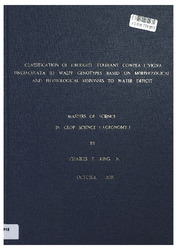| dc.description.abstract | Drought stress poses a major threat to food security due to the devastating effect during the growth and development of plants and leads to yield losses in Africa, especially in Botswana. Therefore, there is an increasing need in providing part of the solutions, and for crops like cowpea through drought tolerance identification and improvement programs. Therefore, identification of drought-tolerant cowpea [ Vigna uguiluculata (L). Walp)] genotypes based on morphological and physiological responses to water deficit was investigated during 8-12 days imposition of drought stress at vegetative stage using 20 cowpea genotypes under green house conditions. On these basis, two preliminary experiments followed by two major experiments were conducted at the Botswana College of Agriculture in 2014/2015 summer period. The preliminary experiments aimed at determining the suitable soil mixture for the entire experiment and the days required to reduce cowpea biomass yield to 50%, while the two major experiments intended to identify drought tolerance cowpea genotypes based on morphological (index) and physiological traits (gaseous exchange and chlorophyll content). The experiments were laid out in a Randomized Complete Block Design with four replications and two treatments (well-watered and drought stressed) for the major experiments. Drought stress significantly (P < 0.05) reduced growth parameters: plant height, leaf area, and biomass yield, shoot dry weight, root dry weight and shoot dry weight. Physiologically, water stress also reduced relative water content (RWC) (P>0.05), chlorophyll content (P<0.05) and gaseous exchange (P<0.05). The biomass mean productivity (BMP) was significantly (P<0.05) reduced biomass yield under well-watered and drought stressed and used to identify tolerant cowpea genotypes respectively.
Overall, the BMP index showed that BCA001 and BCA003 were highly tolerant; BCA002,BCA006, BCA009, BCA016, BCA011 and BCA019 were drought tolerant; BCA004,BCA015 and BCA017 were moderately tolerant ; BCA020, BCA014, BCA013, BCA012,BCA007, BCA008, BCA010, BCA005 and BCA013 were sensitive and highly sensitive. The poor relationship between BMP and gas exchanges [net photosynthesis (R2 = 0.0345), stomata conductance (R2 = 0.040), transpiration (R2= 0.006)] and chlorophyll content results indicated that these were parameters to use for identification of cowpea drought tolerance rather BMP. The BMP results can be wholly used in crop drought tolerance improvement program and breeding in Botswana especially under green house condition. | en_US |

